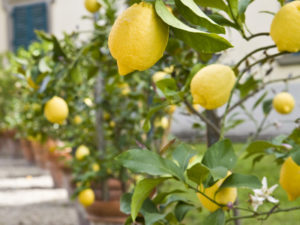 The true lemon tree can reach 10 to 20 ft (3-6 m) in height and usually has sharp thorns on the twigs. The alternate leaves, reddish when young, become dark-green above, light-green below; are oblong, elliptic or long-ovate, 2 1/2 to 4 1/2 in (6.25-11.25 cm) long, finely toothed, with slender wings on the petioles. The mildly fragrant flowers may be solitary or there may be 2 or more clustered in the leaf axils. Buds are reddish; the opened flowers have 4 or 5 petals 3/4 in (2 cm) long, white on the upper surface (inside), purplish beneath (outside), and 20-40 more or less united stamens with yellow anthers. The fruit is oval with a nipple-like protuberance at the apex; 2 3/4 to 4 3/4 in (7 -12 cm) long; the peel is usually light-yellow though some lemons are variegated with longitudinal stripes of green and yellow or white; it is aromatic, dotted with oil glands; 1/4 to 3/8 in (6-10 mm) thick; pulp is pale-yellow, in 8 to 10 segments, juicy, acid. Some fruits are seedless, most have a few seeds, elliptic or ovate, pointed, smooth, 3/8 in (9.5 mm) long, white inside.
The true lemon tree can reach 10 to 20 ft (3-6 m) in height and usually has sharp thorns on the twigs. The alternate leaves, reddish when young, become dark-green above, light-green below; are oblong, elliptic or long-ovate, 2 1/2 to 4 1/2 in (6.25-11.25 cm) long, finely toothed, with slender wings on the petioles. The mildly fragrant flowers may be solitary or there may be 2 or more clustered in the leaf axils. Buds are reddish; the opened flowers have 4 or 5 petals 3/4 in (2 cm) long, white on the upper surface (inside), purplish beneath (outside), and 20-40 more or less united stamens with yellow anthers. The fruit is oval with a nipple-like protuberance at the apex; 2 3/4 to 4 3/4 in (7 -12 cm) long; the peel is usually light-yellow though some lemons are variegated with longitudinal stripes of green and yellow or white; it is aromatic, dotted with oil glands; 1/4 to 3/8 in (6-10 mm) thick; pulp is pale-yellow, in 8 to 10 segments, juicy, acid. Some fruits are seedless, most have a few seeds, elliptic or ovate, pointed, smooth, 3/8 in (9.5 mm) long, white inside.
The true home of the lemon tree is unknown, though some have linked it to northwestern India. It is supposed to have been introduced into southern Italy in 200 A.D. and to have been cultivated in Iraq and Egypt by 700 A.D. It reached Sicily before 1000 and China between 760 and 1297 A.D. Arabs distributed it widely in the Mediterranean region between 1000 and 1150 A.D. It was prized for its medicinal virtues in the palace of the Sultan of Egypt and Syria in the period 1174-1193 A.D. Christopher Columbus carried lemon seeds to Hispaniola in 1493. The Spaniards may have included lemons among the fruits they introduced to St. Augustine. They were grown in California in the years 1751-1768. Lemons were reported to be increasingly planted in northeastern Florida in 1839. Because of heavy imports from Sicily, commercial culture in Florida and California was begun soon after 1870 and grew to the point where 140,000 boxes were being shipped out of Florida alone. The small Florida industry was set back by a freeze in 1886, the susceptibility of the lemon to scab, and the unfavorable climate for curing the fruit, and also competition from California. Following the devastating freeze of 1894-95, commercial lemon culture was abandoned in Florida. Not until 1953 was interest in lemon-growing revived in Central Florida to take advantage of the demand for frozen concentrate and for natural cold-press lemon oil. At that time, Florida was importing lemons from Italy for processing. Plantings grew to 8,700 acres by 1975. Freezes caused 50% reduction by 1980. Still, in 1984, Florida exported $2 million worth of lemons.

